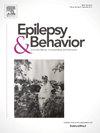Obstructive sleep apnea is associated with risk for sudden unexpected death in epilepsy (SUDEP) using rSUDEP-7
IF 2.3
3区 医学
Q2 BEHAVIORAL SCIENCES
引用次数: 0
Abstract
Background and Objective
Evaluate relationships between PSG-confirmed OSA and SUDEP risk using the revised SUDEP Risk Inventory (rSUDEP-7).
Methods
Identified adults with epilepsy (AWE) who underwent PSG 2004–2016 at Cleveland Clinic. OSA was defined as apnea-hypopnea index (AHI)- ≥-5/h sleep; moderate/severe OSA as AHI≥15. SUDEP risk was assessed using rSUDEP-7: higher rSUDEP-7 score, greater SUDEP risk. Associations between rSUDEP-7 score and OSA groups (AHI≥15 vs. <15) were evaluated using Wilcoxon rank-sum tests and multivariable linear models adjusting for age, sex, BMI, and smoking status. Spearman correlations measured relationships between rSUDEP-7 score with AHI and oxygen desaturation indices (ODI).
Results
OSA was present in 134 (62.6 %) of 214 AWE; moderate/severe in 75 (35 %). AWE with AHI≥15 were more likely to be male and older, had higher BMI, greater frequency of tonic-clonic seizures (TCS), longer epilepsy duration, and more likely to have drug-resistant epilepsy (DRE) and sleep-related seizures (all p< 0.05). The median rSUDEP-7 score was 1 (0,3) but 37.4 % had a score ≥3 (high SUDEP risk), and 11.7 % ≥5 (highest SUDEP risk). rSUDEP-7 scores were higher in those with AHI≥15 (3 vs. 1, p = 0.001). Higher AHI and ODI 3% positively correlated with rSUDEP-7 (p=0.002 and p=0.016) while SpO2 nadir negatively correlated with rSUDEP-7 (p=0.007). After adjustments, AWE with AHI≥15 had mean rSUDEP-7 score 1.14 points (95% CI 0.55–1.72, p<0.001) higher than those with AHI<15.
Discussion
AWE with PSG-confirmed moderate/severe OSA especially those who are older and have GTC had higher rSUDEP-7 scores potentially increasing their risk for SUDEP. Our findings support routine screening for OSA in AWE. Further studies confirming the significance and impact of OSA on SUDEP risk are needed.
使用 rSUDEP-7 预测阻塞性睡眠呼吸暂停与癫痫意外猝死(SUDEP)的风险相关。
背景和目的:使用修订版 SUDEP 风险量表(rSUDEP-7)评估 PSG 证实的 OSA 与 SUDEP 风险之间的关系:使用修订版 SUDEP 风险量表(rSUDEP-7)评估 PSG 证实的 OSA 与 SUDEP 风险之间的关系:确定了 2004-2016 年在克利夫兰诊所接受 PSG 检查的成人癫痫患者 (AWE)。睡眠呼吸暂停-低通气指数(AHI)≥-5/小时定义为 OSA;AHI≥15 为中度/重度 OSA。SUDEP 风险采用 rSUDEP-7 进行评估:rSUDEP-7 分数越高,SUDEP 风险越大。rSUDEP-7 评分与 OSA 组别(AHI≥15 vs. OSA)之间的关系:在 214 名 AWE 中,134 人(62.6%)存在 OSA;75 人(35%)为中度/重度 OSA。AHI≥15的AWE更可能是男性和老年人,体重指数(BMI)更高,强直阵挛发作(TCS)频率更高,癫痫持续时间更长,更可能患有耐药性癫痫(DRE)和与睡眠相关的癫痫发作(所有p2 nadir与rSUDEP-7呈负相关(p=0.007))。经调整后,AHI≥15 的 AWE 平均 rSUDEP-7 得分为 1.14 分(95% CI 0.55-1.72,p 讨论:经 PSG 确认患有中度/重度 OSA 的亚博app客服生,尤其是年龄较大且患有 GTC 的亚博app客服生,其 rSUDEP-7 评分较高,可能会增加他们发生 SUDEP 的风险。我们的研究结果支持对亚博app客服生进行 OSA 常规筛查。还需要进一步研究证实 OSA 对 SUDEP 风险的意义和影响。
本文章由计算机程序翻译,如有差异,请以英文原文为准。
求助全文
约1分钟内获得全文
求助全文
来源期刊

Epilepsy & Behavior
医学-行为科学
CiteScore
5.40
自引率
15.40%
发文量
385
审稿时长
43 days
期刊介绍:
Epilepsy & Behavior is the fastest-growing international journal uniquely devoted to the rapid dissemination of the most current information available on the behavioral aspects of seizures and epilepsy.
Epilepsy & Behavior presents original peer-reviewed articles based on laboratory and clinical research. Topics are drawn from a variety of fields, including clinical neurology, neurosurgery, neuropsychiatry, neuropsychology, neurophysiology, neuropharmacology, and neuroimaging.
From September 2012 Epilepsy & Behavior stopped accepting Case Reports for publication in the journal. From this date authors who submit to Epilepsy & Behavior will be offered a transfer or asked to resubmit their Case Reports to its new sister journal, Epilepsy & Behavior Case Reports.
 求助内容:
求助内容: 应助结果提醒方式:
应助结果提醒方式:


